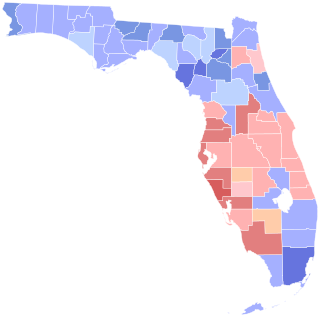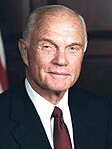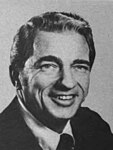
The Ohio Democratic Party (ODP) is the affiliate of the Democratic Party in the U.S. state of Ohio. Summit County Council President Elizabeth Walters has been the party's chairwoman since January 2021.

The 1986 United States Senate elections were elections for the United States Senate. Held on November 4, in the middle of Ronald Reagan's second presidential term, the 34 seats of Class 3 were contested in regular elections. The Republicans had to defend an unusually large number of freshman Senate incumbents who had been elected on President Ronald Reagan's coattails in 1980. Democrats won a net of eight seats, defeating seven freshman incumbents, picking up two Republican-held open seats, and regaining control of the Senate for the first time since January 1981. This remains the most recent midterm election cycle in which the sitting president's party suffered net losses while still flipping a Senate seat.

The 1982 United States Senate elections were held on November 2, 1982. They were elections for the United States Senate following Republican gains in 1980. The 33 Senate seats of Class 1 were up for election in 1982. A total of four seats changed hands between parties, with Democrats winning seats in New Jersey and New Mexico, and Republicans taking seats in Nevada and the seat of the lone independent, Senator Harry Byrd Jr., in Virginia. Democrats made a net gain of one seat bringing them to 46 seats, while Republicans stayed at 54 seats for a majority. However, the Democratic gain in New Jersey replaced a Republican that had been appointed earlier in the year.

The 1976 United States Senate elections was an election for the United States Senate. Held on November 2, the 33 seats of Class 1 were contested in regular elections. They coincided with Democrat Jimmy Carter's presidential election and the United States Bicentennial celebration. Although almost half of the seats decided in this election changed parties, Carter's narrow victory did not provide coattails for the Democratic Party. Each party flipped seven Senate seats, although, one of the seats flipped by Democrats was previously held by a Conservative.

The 1974 United States Senate elections were held on November 5, with the 34 seats of Class 3 contested in regular elections. They occurred in the wake of the Watergate scandal, Richard M. Nixon's resignation from the presidency, and Gerald Ford's subsequent pardon of Nixon. Economic issues, specifically inflation and stagnation, were also a factor that contributed to Republican losses. As an immediate result of the November 1974 elections, Democrats made a net gain of three seats from the Republicans, as they defeated Republican incumbents in Colorado and Kentucky and picked up open seats in Florida and Vermont, while Republicans won the open seat in Nevada. Following the elections, at the beginning of the 94th U.S. Congress, the Democratic caucus controlled 60 seats, and the Republican caucus controlled 38 seats.

The 1972 United States Senate elections were held on November 7, with the 33 seats of Class 2 contested in regular elections. They coincided with the landslide re-election of Republican President Richard Nixon. Despite Nixon's landslide victory, Democrats increased their majority by two seats. The Democrats picked up open seats in Kentucky and South Dakota, and defeated four incumbent senators: Gordon Allott of Colorado, J. Caleb Boggs of Delaware, Jack Miller of Iowa, and Margaret Chase Smith of Maine. The Republicans picked up open seats in New Mexico, North Carolina, and Oklahoma, and defeated one incumbent, William B. Spong Jr. of Virginia.

The 1970 United States Senate elections was an election for the United States Senate. It took place on November 3, with the 33 seats of Class 1 contested in regular elections. Special elections were also held to fill vacancies. These races occurred in the middle of Richard Nixon's first term as president. The Democrats lost a net of three seats, while the Republicans and the Conservative Party of New York picked up one net seat each, and former Democrat Harry F. Byrd Jr. was re-elected as an independent.

The 1964 United States Senate elections were held on November 3. The 33 seats of Class 1 were contested in regular elections. Special elections were also held to fill vacancies. They coincided with the election of President Lyndon B. Johnson by an overwhelming majority, to a full term. His Democratic Party picked up a net two seats from the Republicans. As of 2023, this was the last time either party has had a two-thirds majority in the Senate, which allowed the Senate Democrats to override a veto, propose constitutional amendments, or convict and expel certain officials without any votes from Senate Republicans. However, internal divisions would have prevented the Democrats from having done so. The Senate election cycle coincided with Democratic gains in the House in the same year.

The 1986 United States Senate election in North Dakota was held on November 4, 1986. Incumbent Republican U.S. Senator Mark Andrews ran for re-election to a second term, but was defeated by Democratic-NPL nominee Kent Conrad.

The 1986 United States Senate election in North Carolina was held on November 4, 1986 as part of the nationwide elections to the Senate. Incumbent Republican U.S. Senator Jim Broyhill, who had been appointed in June 1986 to serve out the rest of John Porter East's term, faced off against the popular Democratic former Governor Terry Sanford.

The 1986 United States Senate election in Colorado was held on November 4, 1986. Incumbent Democratic U.S. Senator Gary Hart decided to retire instead of seeking a third term. Democratic nominee Tim Wirth won the open seat.

The 1980 United States Senate election in Ohio took place on November 4, 1980. It was concurrent with elections to the United States House of Representatives. Incumbent Democratic U.S. Senator John Glenn won re-election to a second term in a landslide with nearly 69% of the vote, coinciding with Ronald Reagan's substantial win in the state during the presidential election.

The 1974 United States Senate election in Ohio took place on November 5, 1974. It was concurrent with elections to the United States House of Representatives. Incumbent Democratic U.S Senator Howard Metzenbaum was running for election his first full term after he was appointed in 1974 by Ohio governor John J. Gilligan to fill out the Senate term of William B. Saxbe, who had resigned to become United States Attorney General. Metzenbaum lost the primary election to John Glenn, who went on to win the general election and win every county in the state. Metzenbaum would later be elected in the other U.S. Senate seat in 1976 and worked with Glenn until he retired from the post in 1994.

The 1986 United States Senate election in California took place on November 4, 1986. Incumbent Democratic U.S. Senator Alan Cranston narrowly won re-election to a fourth and final term over Republican U.S. Congressman Ed Zschau. This was the last time where both major party nominees for the Class 3 Senate seat in California were men until 2022.

The 1976 United States Senate election in Maryland took place on November 2, 1976. Incumbent Republican U.S. Senator Glenn Beall Jr. ran for re-election to a second term, but was defeated by Democratic challenger Paul Sarbanes.

The 1974 United States Senate election in Florida was held on November 5, 1974. Incumbent Senator Edward Gurney, a Republican, declined to seek a second term after being indicted for taking bribes in return for his influence with the Federal Housing Administration. The primary for the Republican nomination pitted Eckerd drug store owner Jack Eckerd against Florida Public Service Commissioner Paula Hawkins. Eckerd won handily, receiving approximately 67.5% of the vote. The Democratic primary, however, was a crowded field with eleven candidates vying for the nomination. Because no candidate received a majority of the votes, U.S. Representative Bill Gunter and Secretary of State of Florida Richard Stone advanced to a run-off election. Stone won by a small margin of 1.68%.

The 1970 United States Senate election in Ohio took place on November 3, 1970. Incumbent Democratic Senator Stephen M. Young did not run for re-election to a third term in office. U.S. Representative Robert Taft Jr. won the open seat over Democrat Howard Metzenbaum.

The 1952 United States Senate election in Tennessee was held on November 4, 1952. Incumbent Democratic Senator and President pro tempore of the Senate Kenneth D. McKellar ran for re-election to a seventh term in office but was defeated in the Democratic primary by U.S. Representative Al Gore Sr. Gore easily won the general election against Republican Hobart Atkins.

The 1964 United States Senate election in Ohio took place on November 3, 1964. Incumbent Democratic Senator Stephen M. Young was re-elected to a second term in office, narrowly defeating Republican U.S. Representative Robert Taft, Jr.

The 2020 Kentucky Senate election was held on November 3, 2020. The Republican and Democratic primary elections were held on June 23. Half of the senate seats were up for election. Republicans increased their majority in the chamber, gaining two seats.
























